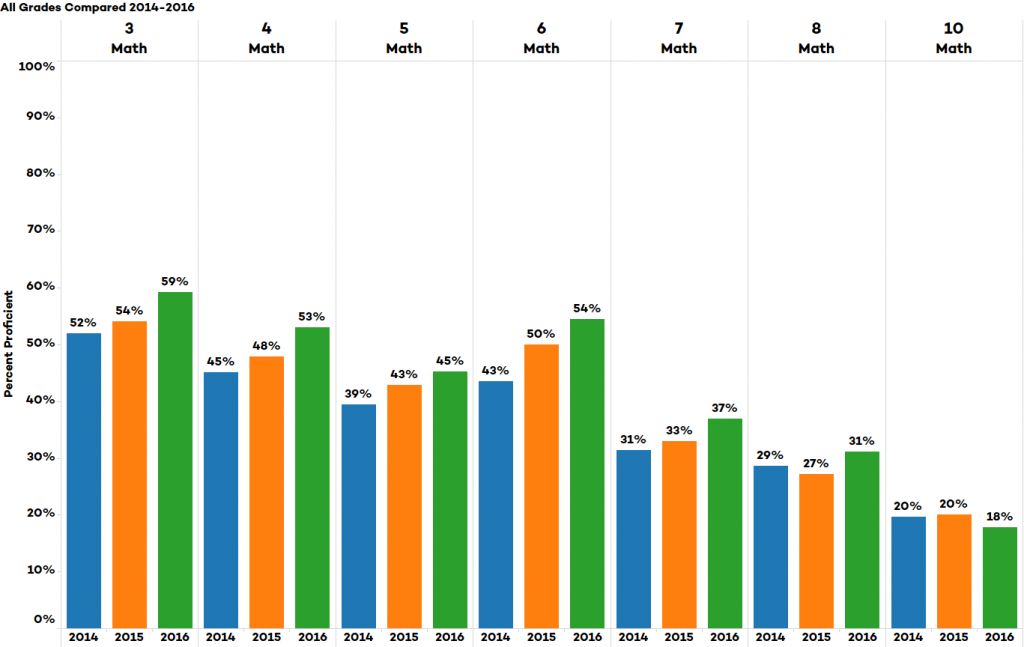New data show Alabama students improving performance in math, reading, and science on the ACT Aspire, the year-end standardized tests given to students across Alabama. In all three subjects, the percentage of students scoring proficient improved, at almost all grade levels.
At the same time, long-term weaknesses persist. While math performance is improving in the early grades, and most encouragingly in 7th and 8th grade, by 10th grade, only 18 percent of students test proficient in math. And in reading, 32 percent of 10th graders scored proficient. Scoring proficient on the Aspire indicates that a student is on track to be ready for college-level work in that subject. The results for 10th graders in reading, math and science are similar to performance levels posted by Alabama student performance on the ACT in 2016. PARCA recently reported on those scores.
In releasing the results, Alabama’s new State Superintendent Michael Sentance noted areas of improvement and showcased schools systems that showed high performance or high levels of gain. But he noted that challenges, particularly in the upper grades, are “clearly daunting.”
This is the third year all schools statewide have administered the Aspire, a suite of tests developed by ACT, a company most widely known for its college readiness test, the ACT.
Statewide, the percentage of students scoring proficient in math rose in all grades, except 10th. This continues the trend of improvement in math, particularly in the early grades, where the gains have been largest.
In reading, the percentage of students scoring proficient also improved in all grades 3-8, except for 6th grade, which saw 42 percent of students scoring proficient compared to 43 percent of students in 2015. The improvement in reading proficiency, while not dramatic, is better than last year’s results when performance was flat or slightly declining in comparison to 2014.

This is the second year that all students in grades 3-10 took an Aspire assessment for science. Again, in all grades the percentage of students scoring proficient improved except 6th grade where the proficiency percentage matched the 2015 level.

Students take the Aspire again in 10th grade. The results are shown below. For 2016, students took the reading assessment rather than the English assessment that they’d taken the previous two years. That means comparison year-over-year comparison data is not available. However, these 10th-grade results are similar to those Alabama has typically produced when taking the ACT. In 2016, 22 percent of the graduating class of 2016 scored at the college-ready level on the ACT; 22 percent in science; 32 percent in reading.

Speaking to the State Board of Education, Sentance said that Alabama needs to improve its performance and pointed to the Chicago Cub’s historic World Series win this fall as evidence that there’s no curse that can’t be broken with sustained effort.
State School Board member Mary Scott Hunter agreed and added a quip: “We are not going to wait 100 years,” she said.
The interactive data tool below allows for in-depth exploration of the results at the system and school level. Use the available filter to select for your system and school results. When making comparisons across schools and systems, it is important to keep in mind the demographic mix of the student body. Across Alabama and the nation, the proficiency rate of poverty students lags about 30 percentage points behind the proficiency rate of nonpoverty students. Schools and system that serve large numbers of students from poverty households tend to show lower overall proficiency rates when compared to schools with lower poverty rates. In the 2016 Alabama Aspire results, that gap persists.
Another important note on the data: To protect student privacy, the State Department of Education does not publish results for demographic subgroups where there are only a small number of students in that group. Therefore, in instances where there are a small number of students in the test group, no results will appear.

